控制面板使用说明(EN)
Hikvision 数字控制面板用户手册说明书
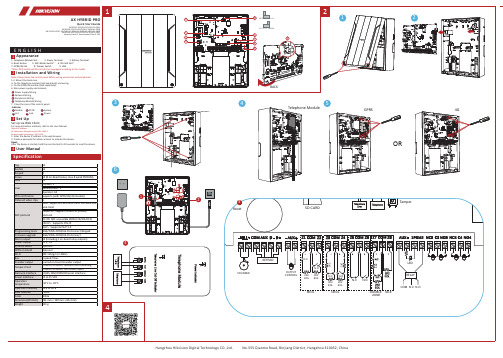
64 64 8 64 (8 on-board zones, max 8 wired PIRCAM) 32 Installer: 1 Administrator: 1 Operator: 62 Supports (with GPRS/3G/4G module) 4 ISAPI: Supports iVMS-4200 client software and web client Cloud P2P: Supports cloud P2P privacy protocol DC-09: ARC accessible (ADM-CID/SIA-DCS) CSV-IP:Supports CSV-IP ISUP:Supports ISUP 5.0 Web/iVMS-4200/Hik-ProConnect/Keypad Web/iVMS-4200/Hik-ProConnect 64 (Including 2 on-board relay outputs) 12 V, 1 A Optional Optional 802.11b/g/n (2.4GHz) 1 speed-X bus 1 wired on-board sounder output 1 switch to detect removal from mounting 1 switch to detect front cover open 1 RJ45 10M/100M Ethernet interface 12 to 15 VDC
Security Grade 2, Environment Class II, SP4
控制面板说明书
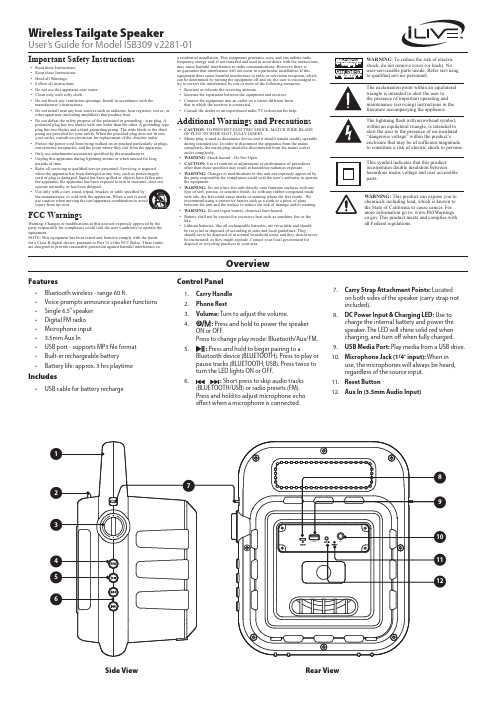
Control Panel1. Carry Handle2. Phone Rest3. Volume: Turn to adjust the volume.4.: Press and hold to power the speaker ON or OFF.Press to change play mode: Bluetooth/Aux/FM.5.: Press and hold to begin pairing to aBluetooth device (BLUETOOTH). Press to play or pause tracks (BLUETOOTH, USB). Press twice to turn the LED lights ON or OFF.6.: Short press to skip audio tracks(BLUETOOTH/USB) or radio presets (FM). Press and hold to adjust microphone echo effect when a microphone is connected.7. Carry Strap Attachment Points: Locatedon both sides of the speaker (carry strap not included).8. DC Power Input & Charging LED: Use tocharge the internal battery and power the speaker. The LED will shine solid red when charging, and turn off when fully charged.9. USB Media Port: Play media from a USB drive.10. Microphone Jack (1/4˝ input): When inuse, the microphones will always be heard, regardless of the source input.11. Reset Button12. Aux In (3.5mm Audio Input)Important Safety Instructions• Read these Instructions.• Keep these Instructions.• Heed all Warnings.• Follow all instructions.• Do not use this apparatus near water.• Clean only with a dry cloth.• Do not block any ventilation openings. Install in accordance with the manufacturer’s instructions.• Do not install near any heat sources such as radiators, heat registers, stoves, or other apparatus (including amplifiers) that produce heat.•Do not defeat the safety purpose of the polarized or grounding - type plug. A polarized plug has two blades with one wider than the other. A grounding type plug has two blades and a third grounding prong. The wide blade or the third prong are provided for your safety. When the provided plug does not fit into your outlet, consult an electrician for replacement of the obsolete outlet.• Protect the power cord from being walked on or pinched particularly at plugs, convenience receptacles, and the point where they exit from the apparatus.• Only use attachments/accessories specified by the manufacturer.• Unplug this apparatus during lightning storms or when unused for long periods of time.•Refer all servicing to qualified service personnel. Servicing is required when the apparatus has been damaged in any way, such as power-supply cord or plug is damaged, liquid has been spilled or objects have fallen into the apparatus, the apparatus has been exposed to rain or moisture, does not operate normally, or has been dropped.•Use only with a cart, stand, tripod, bracket, or table specified by the manufacturer, or sold with the apparatus. When a cart is used, use caution when moving the cart/apparatus combination to avoid injury from tip-over.FCC WarningsWarning: Changes or modifications to this unit not expressly approved by the party responsible for compliance could void the user’s authority to operate the equipment.NOTE: This equipment has been tested and found to comply with the limits for a Class B digital device, pursuant to Part 15 of the FCC Rules. These limits are designed to provide reasonable protection against harmful interference inOverviewWireless Tailgate SpeakerUser’s Guide for Model ISB309 v2281-01a residential installation. This equipment generates, uses, and can radiate radio frequency energy and, if not installed and used in accordance with the instructions, may cause harmful interference to radio communications. However, there is no guarantee that interference will not occur in a particular installation. If this equipment does cause harmful interference to radio or television reception, which can be determined by turning the equipment off and on, the user is encouraged to try to correct the interference by one or more of the following measures:• Reorient or relocate the receiving antenna.• Increase the separation between the equipment and receiver.• Connect the equipment into an outlet on a circuit different from that to which the receiver is connected.• Consult the dealer or an experienced radio/TV technician for help.Additional Warnings and Precautions• CAUTION : TO PREVENT ELECTRIC SHOCK, MATCH WIDE BLADE OF PLUG TO WIDE SLOT, FULLY INSERT.• Mains plug is used as disconnect device and it should remain readily operable during intended use. In order to disconnect the apparatus from the mains completely, the mains plug should be disconnected from the mains socket outlet completely.• WARNING : Shock hazard - Do Not Open.• CAUTION: Use of controls or adjustments or performance of procedures other than those specified may result in hazardous radiation exposure.• WARNING: Changes or modifications to this unit not expressly approved by the party responsible for compliance could void the user’s authority to operate the equipment.• WARNING: Do not place this unit directly onto furniture surfaces with any type of soft, porous, or sensitive finish. As with any rubber compound made with oils, the feet could cause marks or staining where the feet reside. We recommend using a protective barrier such as a cloth or a piece of glassbetween the unit and the surface to reduce the risk of damage and/or staining.• WARNING: Do not ingest battery, chemical burn hazard.• Battery shall not be exposed to excessive heat such as sunshine, fire or the like.• Lithium batteries, like all rechargeable batteries, are recyclable and should be recycled or disposed of according to state and local guidelines. Theyshould never be disposed of in normal household waste and they should never be incinerated, as they might explode. Contact your local government for disposal or recycling practices in your area.WARNING : To reduce the risk of electric shock, do not remove cover (or back). No user-serviceable parts inside. Refer servicing to qualified service personnel.WARNING: This product can expose you to chemicals including lead, which is known to the State of California to cause cancer. For more information go to: This product meets and complies with all Federal regulations.The exclamation point within an equilateral triangle is intended to alert the user to the presence of important operating and maintenance (servicing) instructions in the literature accompanying the appliance.This symbol indicates that this product incorporates double insulation betweenhazardous mains voltage and user accessible parts.The lightning flash with arrowhead symbol, within an equilateral triangle, is intended to alert the user to the presence of un-insulated “dangerous voltage” within the product’s enclosure that may be of sufficient magnitude to constitute a risk of electric shock to persons.Side View Rear ViewFeatures• Bluetooth wireless - range 60 ft.• Voice prompts announce speaker functions • Single 6.5” speaker • Digital FM radio • Microphone input • 3.5mm Aux In• USB port - supports MP3 file format • Built-in rechargeable battery•Battery life: approx. 3 hrs playtimeIncludes•USB cable for battery rechargeMicrophoneRequires a microphone with a 1/4˝ audio cable or 1/4˝ adapter (not included). 1. Connect a microphoneto the Microphone Input on the unit. The speaker will play audio from the microphone as long as it is connected.2. Use the Volume Dialto adjust the overall volume of the speaker and microphone. Pressand hold thebuttons to adjust the echo effect of the microphone.To download this User’s Guide in English, Spanish, or French, or to get answers to frequently asked questions, visit the support section at: Para descargar este Manual del Usuario en inglés, español y francés, o para obtener respuestas a preguntas frecuentes, visite la sección de apoyo en: Pour télécharger ce guide de l’utilisateur en anglais, espagnol ou français, ou pour obtenir des réponses à des questions fréquemment posées, consultez la rubrique d’assistance sur: For Warranty Information and the most up-to-date version of this User’s Guide, go to Customer Service: 1-888-999-4215 | Email Support:*******************|Email Parts:********************Copyright © 2018 Digital Products International (DPI, Inc.) All other trademarks appearing herein are the property of their respective owners. Specifications are subject to change without notice.Customer SupportProtect for T oday Sustain for T omorrowMade GreenAux InRequires a 3.5mm audio cable (not included).1. Connect a 3.5mmaudio cable to the Aux In on the unit and the audio output/headphone jack on an audio device. 2. Press Source to switchto Aux Mode.3. Use the controls on theconnected device to select and play audio. Be sure the volume on your connected device is audible when you begin playing.Bluetooth WirelessPairing & Playing AudioAfter initial pairing, the unit will stay paired unless unpaired manually by the user or erased due to a reset of the device. If your device should become unpaired or you find it is unable to connect, repeat the steps listed here.1. Press thebutton to select Bluetooth Mode, indicated by the voice prompt “Bluetooth”. 2. Press and hold the button to enter pairing mode, indicated by the voiceprompt “Bluetooth is connecting.” The speaker will now be discoverable by your Bluetooth device.3. On your Bluetooth device, scan for and select ISB309 in your Bluetoothsettings to pair. If your device requests a password, enter the default password 0 0 0 0 . Refer to the user’s manual for your specific device for instructions on pairing and connecting Bluetooth devices. 4. When successfully paired, the voice prompt will say “Bluetooth connected.”Use the controls on your connected device to select and begin playing audio. Use the controls on the speaker or the connected device to play, pause, and adjust volume.USB1. Load a USB driveinto the USB Media port. The speaker will automatically switch to USB Mode, indicated by a voice prompt. You can also press the Source button to switch to USB Mode manually.2. Use the controls on thespeaker to select and play audio from the connected drive.FM RadioRadio ReceptionAn FM receiver is built into the speaker. Adjust the position of the speaker to improve FM radio reception.Radio Tuning and Saving Station Presets1. Press the button to select FM Radio Mode, this will be indicated by avoice prompt. 2. Press and hold thebutton to scan and save radio stations automatically.3. Press thebuttons to cycle through saved radio stations. Press and hold to manually search through FM radio frequencies.Charging the BatteryTo power the unit or charge the internal battery, plug the USB charging cable into the DC Power Input on the speaker and a powered on computer or USB power adapter (not included) and standard power outlet. Battery life is approximately3 hours.。
控制面板按键操作及屏显功能说明

一、控制面板按键操作及屏显功能说明:●开关开启及关闭电源,触摸(按)一次进入工作状态,显示屏显示进入待机状态标志,再触摸(按)一次关闭电源。
●功能功能选择键,触摸(按)一次选择一种功能,可按顺序循环选择,当功能选定后,电磁炉便会自动默认工作。
●童锁在选定某一功能进入工作后,触摸(按)“童锁”,电磁炉便会锁定或解除工作状态,关机也会自动解除锁定。
●火锅/煎炒/烧烤按上述键进入相应功能工作状态,按“增大”或“减小”键调节火力,按“定时”键进入时间设定,按“增大”或“减小”键设定时间。
●烧水/泡茶/煮饭/热奶/暖酒/煲汤/煲粥/蒸炖按上述智能键进入相应自动功能工作状态,加热过程自动调节功率。
●保温按此键进入自动保温状态。
●快速加热/火力按上述键进入快速加热状态,按“增大”或“减小”键调节火力,按“定时”键进入时间设定,按“增大”或“减小”键设定时间。
●定时按此键,进入时间设定状态,但在自动功能状态无此作用。
●增大/减小调节定时、火力、温度的大小,但在自动功能状态无此作用。
以上功能键在操作时均点亮相对应的指示灯,并且屏幕显示相应的动态数字。
在每一个加热功能结束蜂鸣器有“DiDi”报警提示音,风扇旋转1-3分钟将机内余热吹散后停止转动。
风扇停止转动后才可拔掉电源。
二、自动功能详叙自动煮饭:首先以适当功率加热至60℃,恒温吸水,加热至水干后,进入焖饭。
自动煲汤:首先以适当功率加热,加热一段时间后,转入小功率慢炖。
自动烧水:以最大功率迅速将水煮开一段时间后,自动关机。
自动热奶:首先以适当功率加热至60-80℃后,维持该温度约30秒进行巴氏灭菌,并自动转入保温,10分钟后自动关机。
三、准备工作1.将电磁炉水平放置,每边与墙或其它物品要留10cm以上间隙。
2.将电源插头插入220V AC/10A以上的专用插座上,电磁炉进行自检,蜂鸣器报警一声,然后进入待机状态。
3.将盛有料理的专用锅具置于电磁炉面板中央。
4.根据需要选择相应的功能进行操作。
控制面板的操作说明
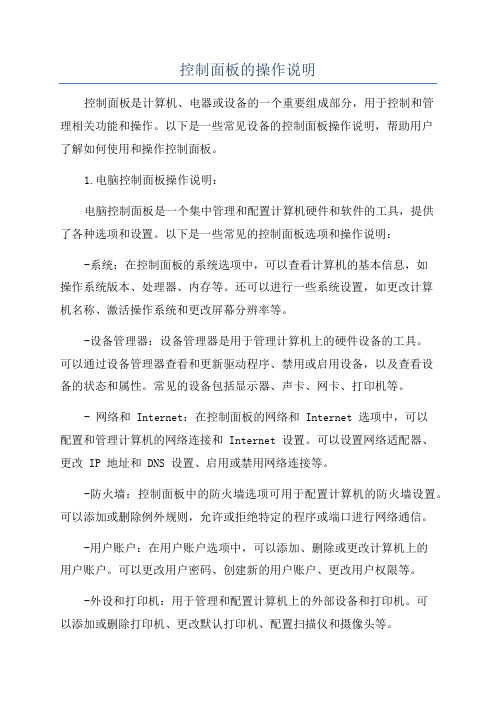
控制面板的操作说明控制面板是计算机、电器或设备的一个重要组成部分,用于控制和管理相关功能和操作。
以下是一些常见设备的控制面板操作说明,帮助用户了解如何使用和操作控制面板。
1.电脑控制面板操作说明:电脑控制面板是一个集中管理和配置计算机硬件和软件的工具,提供了各种选项和设置。
以下是一些常见的控制面板选项和操作说明:-系统:在控制面板的系统选项中,可以查看计算机的基本信息,如操作系统版本、处理器、内存等。
还可以进行一些系统设置,如更改计算机名称、激活操作系统和更改屏幕分辨率等。
-设备管理器:设备管理器是用于管理计算机上的硬件设备的工具。
可以通过设备管理器查看和更新驱动程序、禁用或启用设备,以及查看设备的状态和属性。
常见的设备包括显示器、声卡、网卡、打印机等。
- 网络和 Internet:在控制面板的网络和 Internet 选项中,可以配置和管理计算机的网络连接和 Internet 设置。
可以设置网络适配器、更改 IP 地址和 DNS 设置、启用或禁用网络连接等。
-防火墙:控制面板中的防火墙选项可用于配置计算机的防火墙设置。
可以添加或删除例外规则,允许或拒绝特定的程序或端口进行网络通信。
-用户账户:在用户账户选项中,可以添加、删除或更改计算机上的用户账户。
可以更改用户密码、创建新的用户账户、更改用户权限等。
-外设和打印机:用于管理和配置计算机上的外部设备和打印机。
可以添加或删除打印机、更改默认打印机、配置扫描仪和摄像头等。
2.家用电器控制面板操作说明:家用电器的控制面板通常位于设备的前面板或侧面板,用于控制设备的各种功能和设置。
以下是一些家用电器的控制面板操作说明:-空调控制面板:空调控制面板用于设置温度、风速和模式等。
可以通过控制面板设置制冷或制热模式,调整风速和风向,设置定时开关机等。
-冰箱控制面板:冰箱控制面板用于设置冷冻室和冷藏室的温度,以及冰箱的其他功能。
可以通过控制面板调整温度、打开快速冷冻或快速制冷功能等。
控制面板的操作说明
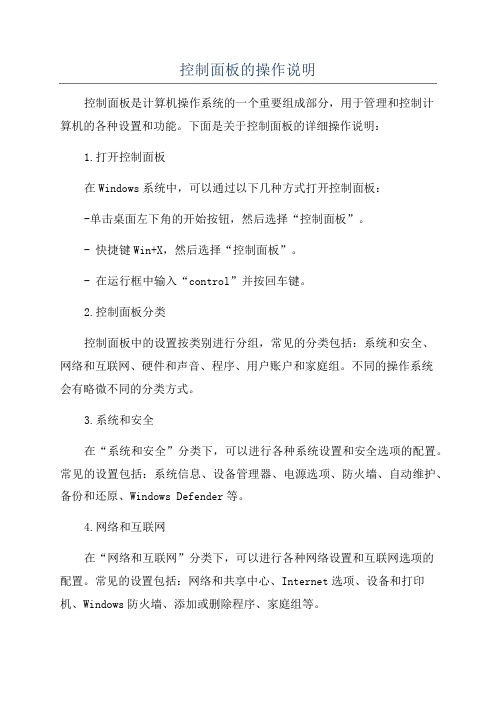
控制面板的操作说明控制面板是计算机操作系统的一个重要组成部分,用于管理和控制计算机的各种设置和功能。
下面是关于控制面板的详细操作说明:1.打开控制面板在Windows系统中,可以通过以下几种方式打开控制面板:-单击桌面左下角的开始按钮,然后选择“控制面板”。
- 快捷键Win+X,然后选择“控制面板”。
- 在运行框中输入“control”并按回车键。
2.控制面板分类控制面板中的设置按类别进行分组,常见的分类包括:系统和安全、网络和互联网、硬件和声音、程序、用户账户和家庭组。
不同的操作系统会有略微不同的分类方式。
3.系统和安全在“系统和安全”分类下,可以进行各种系统设置和安全选项的配置。
常见的设置包括:系统信息、设备管理器、电源选项、防火墙、自动维护、备份和还原、Windows Defender等。
4.网络和互联网在“网络和互联网”分类下,可以进行各种网络设置和互联网选项的配置。
常见的设置包括:网络和共享中心、Internet选项、设备和打印机、Windows防火墙、添加或删除程序、家庭组等。
5.硬件和声音在“硬件和声音”分类下,可以进行各种硬件设备和音频设置的配置。
常见的设置包括:设备和打印机、显示、音频设备、麦克风配置、键盘、鼠标、麦克风等。
6.程序在“程序”分类下,可以进行各种程序设置和默认程序的配置。
常见的设置包括:卸载程序、默认程序、程序和功能、自动启动程序、Windows更新等。
7.用户账户和家庭组在“用户账户和家庭组”分类下,可以进行用户账户的管理和家庭网络设置的配置。
常见的设置包括:用户账户、家庭网络、家长控制、凭据管理器、管理员工具等。
8.控制面板中的常用设置-更改桌面壁纸:在控制面板中找到“个性化”选项,选择“桌面背景”,然后选择所需的壁纸。
-更改屏幕分辨率:在控制面板中找到“显示”选项,选择“调整分辨率”,然后选择合适的分辨率。
-添加或删除打印机:在控制面板中找到“设备和打印机”选项,选择“添加打印机”或“删除打印机”。
控制面板的操作说明
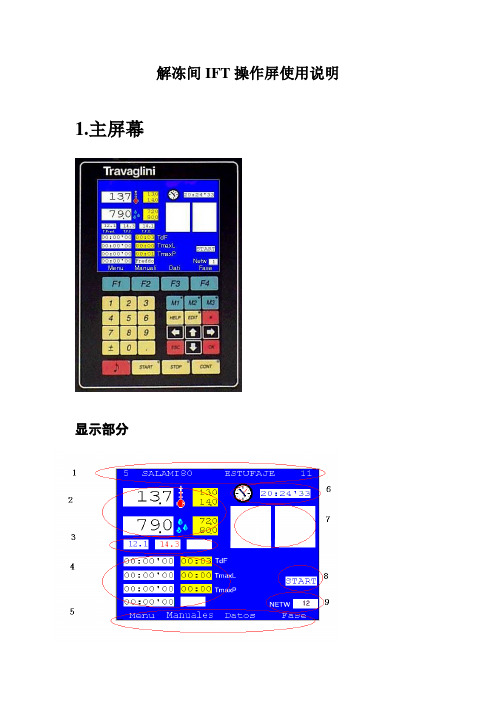
解冻间IFT操作屏使用说明1.主屏幕显示部分➢1: 程序号(5), 程序名(SALAMI80), 调用程序名(ESTUFAJE), 目前运行的子程序序号(11).➢2: 温度值(13.7),温度设定上下限范围(13.0,14.0), 湿度值(79.0), 湿度范围(72.0,80.0).➢3: 其他温度值. 如解冻间, 一般第一个是产品中心温度, 第二个是产品表面温度, 第三个是盘管内温度.➢4: 目前运行工作时间状态. 如TdF表示此子程序的最大持续时间. TmaxL表示最大工作时间, TmaxP表示最大休息时间. 左边白色框内为剩余时间, 右边为设定时间.➢5: 各子菜单名. LIST 主菜单MANUAL 可手动起动项DA TA各项数据PHASE 子程序内容.➢6: 时钟➢7: 工作状态显示.左边是工作状态的时间显示, 右边是各部件起动情况➢8: 设备启动报警显示.➢9: 网络地址操作部分➢F1,F2,F3,F4—对应正上方显示屏显示的内容.➢数字区0~9—为可选择输入数字,小数点及正负号.➢编辑区—M1,M2,M3 为快捷键,可直接启动设备的某些功能。
如一般的设定M1-手动离心风机运行,M2-排风,M3-定时排风。
此项手动运行功能也可在主页面下,按F2(MANUAL)进入。
HELP可以查看各英文缩写的具体含义。
EDIT为编辑键,在需要修改参数时,按此键进行修改。
上下左右箭头可移动光标,或者屏幕,或者数值,或者选择字母等功能。
ESC是退出键。
OK 是确认。
➢报警按钮,当有报警时会有报警声且有灯闪动。
START开机。
STOP关机。
CONT继续。
2.设定程序所有SSC控制面板设定程序的步骤都一样,现以解冻为例第一步按F1 MENU1>Programs 程序2>Alarms报警3>V ersion版本4>Configuration 设置n5>Password密码6>Maintenance维护第二步按1>Programs1>Create/Change program (创建程序)2> Read Program(读程序)3>Program Save(保存程序)4>Program list(程序列表)5>Delete program(删除程序)第三步按1>Create/Change programF1 insert 插入F2 delete 删除F3 list 列表F4 help 帮助第四步按F1 insert第五步选择插入位置,按上下键即可。
E5CN AN EN-H 温度控制器 说明书
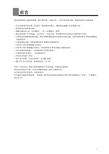
前言E5CN/AN/EN-H温度控制器(数字调节器)功能介绍。
下述内容包括功能、性能和使用方法的信息。
·为可选择使用热电偶、铂电阻、模拟量电压输入、模拟量电流输入的多重输入型。
·新增加热冷却控制功能。
·调整功能包括AT(自动整定)、ST(自我整定)选择。
·通过事件输入可对Bank、运行/停止、自动/手动、简易程序的启动/复位功能等进行切换。
·可使用加热器断线检测功能、SSR故障检测功能及加热器过电流功能(E5CN/AN/EN-H带加热器断线功能的机型)。
·可使用通信功能(E5CN/AN/EN-H带通信功能的机型)。
·支持用户进行传感器输入的校正。
·支持用户进行传感输出的校正(E5AN/EN-H带传送输出功能的机型)。
·对应位置比例控制。
(E5AN/EN-H位置比例型)·可使用远程SP输入。
(E5AN/EN-H)·具有防水构造(IP66)。
·符合安全标准(UL/CSA/IEC)及EMC标准。
·通过PV显示色切换,使进程状态一目了然。
本用户手册记述了使用E5CN/AN/EN-H时的功能、性能及注意事项。
事先充分阅读本手册,在充分理解的基础上进行正确的应用。
本手册可经常作为参考,请妥善保存。
有关通信功能的详细说明,请参阅「E5CN-H/E5AN-H/E5EN-H数字调节器通信用户手册」(手册编号:SGTD-737)。
I使用时的注意事项1.品质保证①保证期间本公司的保证期限为从本公司向贵公司提供产品1年后。
②保证范围在上述保证期限内产品出现质量问题,本公司负责免费对故障产品进行维修或更换,用户可以在购买处进行更换或要求维修,但下列情形除外:a) 在产品目录及设计•规格书规定的条件、环境、使用方法外使用而引起故障;b) 本公司产品以外的原因引起的故障c) 非本公司进行的改造或者修理引起的故障d) 未按本公司产品固有使用方法使用的e) 产品投入流通时的科学技术水平尚不能发现的缺陷f) 由于不可抗力等其他非本公司责任导致的另,本条所述保证是指对本公司产品本身的保证,就本公司产品的故障所引起的其他人身和财产的损害,不在本保证范围之内。
控制面板按键操作及屏显功能说明
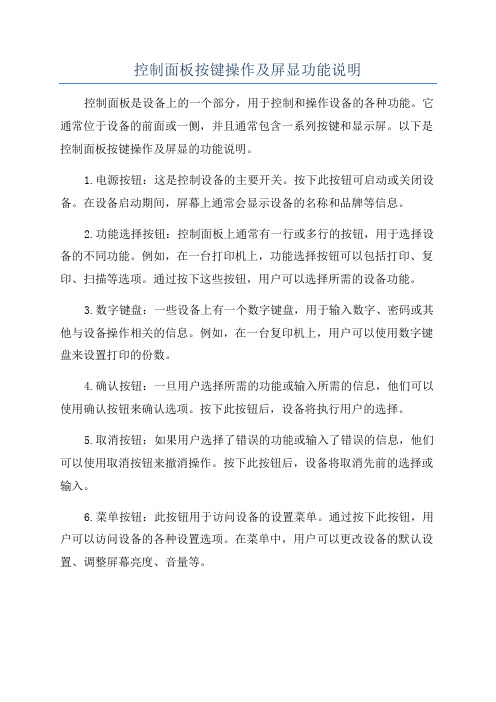
控制面板按键操作及屏显功能说明控制面板是设备上的一个部分,用于控制和操作设备的各种功能。
它通常位于设备的前面或一侧,并且通常包含一系列按键和显示屏。
以下是控制面板按键操作及屏显的功能说明。
1.电源按钮:这是控制设备的主要开关。
按下此按钮可启动或关闭设备。
在设备启动期间,屏幕上通常会显示设备的名称和品牌等信息。
2.功能选择按钮:控制面板上通常有一行或多行的按钮,用于选择设备的不同功能。
例如,在一台打印机上,功能选择按钮可以包括打印、复印、扫描等选项。
通过按下这些按钮,用户可以选择所需的设备功能。
3.数字键盘:一些设备上有一个数字键盘,用于输入数字、密码或其他与设备操作相关的信息。
例如,在一台复印机上,用户可以使用数字键盘来设置打印的份数。
4.确认按钮:一旦用户选择所需的功能或输入所需的信息,他们可以使用确认按钮来确认选项。
按下此按钮后,设备将执行用户的选择。
5.取消按钮:如果用户选择了错误的功能或输入了错误的信息,他们可以使用取消按钮来撤消操作。
按下此按钮后,设备将取消先前的选择或输入。
6.菜单按钮:此按钮用于访问设备的设置菜单。
通过按下此按钮,用户可以访问设备的各种设置选项。
在菜单中,用户可以更改设备的默认设置、调整屏幕亮度、音量等。
7.上下左右按钮:这些按钮通常位于设备面板的中央或底部。
它们用于在设备的菜单、文件夹或列表中进行导航。
通过按下这些按钮,用户可以在屏幕上浏览不同的选项或文件。
8.回车按钮:在一些设备上,有一个回车按钮用于确认和执行所选操作。
当用户在选项或文件上移动并希望执行该操作时,他们可以按下回车按钮。
9.显示屏:控制面板上通常有一个显示屏,用于显示设备的状态和信息。
这些信息可以包括设置选项、故障代码、任务进度等。
显示屏还可以显示设备的菜单和用户的输入。
10.状态指示灯:控制面板上的状态指示灯用于显示设备的状态。
这些指示灯可以指示设备是否打开、是否正在操作、是否需要更换耗材等。
总的来说,控制面板按键操作和屏显功能使得设备更加易于使用和操作。
控制面板使用方法

控制面板使用方法控制面板是Windows系统的一个重要组成部分,可以用于管理和控制计算机硬件、软件和网络设置等。
它包含了许多实用的工具和选项,可以帮助用户更好地管理计算机系统。
本文将介绍控制面板的基本使用方法,并提供一些有用的技巧和提示。
1. 访问控制面板要访问控制面板,可以通过以下几种方式:- 在Windows开始菜单中,选择“控制面板”选项。
- 使用Windows搜索栏,输入“控制面板”并按回车键。
- 在文件资源管理器中,选择“计算机”或“此电脑”,然后点击顶部的“管理”选项,在弹出的菜单中选择“控制面板”。
2. 控制面板分类控制面板工具可以按类别或图标方式显示。
按类别显示会将所有设置划分为不同的类别,例如“硬件和声音”、“网络和Internet”、“用户账户和家庭安全”等。
按图标显示则以图标的形式列出所有设置,更直观方便。
3. 常用控制面板设置以下是一些常用的控制面板设置,它们可以帮助您更好地管理和优化计算机系统:- 系统和安全。
在这个类别下,您可以访问计算机的一些基本设置,例如设备管理器、系统恢复、安全中心、Windows防火墙和自动维护等。
- 程序。
在这个类别下,您可以添加或删除程序、启用或停用Windows 功能、更改默认程序、查看计算机性能和状态等。
- 用户账户和家庭安全。
这个类别下可以设置家长控制、用户账户、管理凭据和网络设置等。
- 硬件和声音。
在这个类别下,您可以设置打印机、音频设备、麦克风、鼠标和键盘等硬件设备。
- 网络和Internet。
在这个类别下,您可以设置互联网连接、网络共享、家庭组、Internet选项、网络和共享中心等。
4. 自定义控制面板您可以将控制面板设置为自己常用的方式,以快速访问您需要的设置。
例如,可以将网络和Internet设置添加到快速访问工具栏中,以便在需要的时候快速打开。
您还可以使用“固定到开始屏幕”选项将常用设置添加到Windows开始屏幕上,更方便快捷。
CE认证 -- EN60204-1-
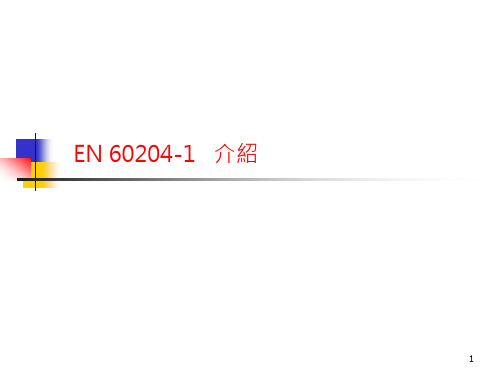
EN60204-1 安全裝置(Safety device) —重要的電控元件與安全有關之 極限開關、偵測裝置,
須使用有 EN 13849 & EN1088 認證之產品。
4
依據 EN60204-1 , EMG. STOP 裝置停止功能的規範如下:
• 停止類別0 : 機器停止 隔離入力電源 • 停止類別1 : 仍有電源通往 控制迴路, 制動機械 停止運作。
5
EN60204-1安全裝置(Safety
device)—總斷電開關裝置
三相電源入線處之重電端子台須: 使用符合EN 60947-2 / EN 60947-3之CE認證規格品; 開(On)標示∣; 關(Off)標示 O; 斷路器在O與∣間要有一重置功能(Reset/Tripped); 在Off位置(O位置)時可上鎖; 具黑色或灰色之外部操作把手; 提供觸電防護(防止手指觸及); 貼附 警告標誌; 入電相線(一次側)要標示L1、L2及L3,地線標示PE。
18
19
20
21
EN60204-1 EMC措施 電源入電 建議加裝適當容量之EMC FILTER(濾波器)以避免產生電磁干擾。
22
電箱內部 配線 顏色須符合EN60204
保護接地迴路:
電力中性迴路: Interlock迴路: 動力(一次側)迴路: 控制迴路(AC交流) : 控制迴路(DC直流) :
13
EN60204-1啟動停止開關 —顏色
查核結果: 適當符合
顏色 紅 黃 綠 藍 白 灰
意義 緊急 不正常 正常 強制
無特殊意義
應用範例 緊急停止 異常狀態的指示
啟動 重置 啟動 啟動;停止 停止
14
EN60204-1啟動指示燈--顏色 查核結果: 適當符合
控制面板说明书模板
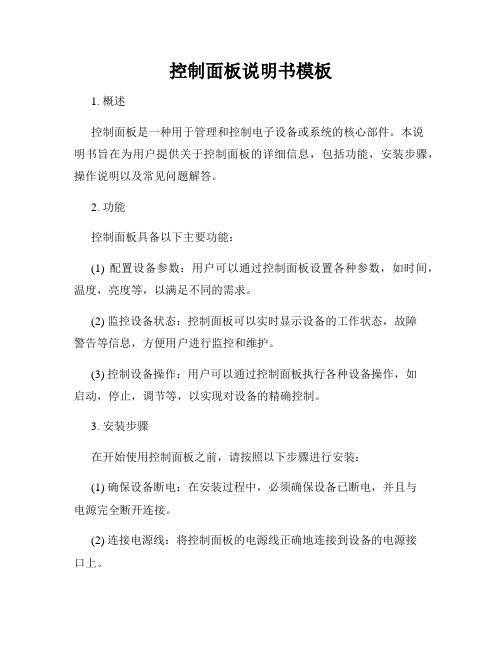
控制面板说明书模板1. 概述控制面板是一种用于管理和控制电子设备或系统的核心部件。
本说明书旨在为用户提供关于控制面板的详细信息,包括功能,安装步骤,操作说明以及常见问题解答。
2. 功能控制面板具备以下主要功能:(1) 配置设备参数:用户可以通过控制面板设置各种参数,如时间,温度,亮度等,以满足不同的需求。
(2) 监控设备状态:控制面板可以实时显示设备的工作状态,故障警告等信息,方便用户进行监控和维护。
(3) 控制设备操作:用户可以通过控制面板执行各种设备操作,如启动,停止,调节等,以实现对设备的精确控制。
3. 安装步骤在开始使用控制面板之前,请按照以下步骤进行安装:(1) 确保设备断电:在安装过程中,必须确保设备已断电,并且与电源完全断开连接。
(2) 连接电源线:将控制面板的电源线正确地连接到设备的电源接口上。
(3) 连接信号线:根据设备的规格要求,将控制面板的信号线连接到设备的相应接口上。
(4) 固定控制面板:使用提供的螺丝或支架,将控制面板固定在设备适当的位置上。
(5) 连接其他设备:根据需要,将其他与控制面板配套的设备连接到主设备上,确保信号的传递和交互能够正常进行。
4. 操作说明(1) 开机和关机:按下控制面板上的电源按钮,设备将启动或关闭。
(2) 参数设置:通过控制面板上的菜单或按钮,用户可以进入参数设置界面,并根据需求调整各种参数。
(3) 状态监控:控制面板上的显示屏可以实时显示设备的状态信息,如温度,湿度,电池电量等。
用户可以随时监控设备的运行情况。
(4) 错误提示和警告:如果设备出现故障或异常情况,控制面板将及时显示错误提示或警告信息,用户可以根据提示进行相应的处理。
(5) 数据保存和导出:控制面板通常具备数据保存和导出功能,用户可以将设备记录的数据保存到存储介质或导出到其他设备进行分析和处理。
5. 常见问题解答以下是一些用户常见的问题及解答:(1) 无法启动设备:请检查控制面板的电源连接是否正确,设备是否处于正常工作状态。
控制面板使用方法

控制面板使用方法介绍控制面板是一个用于管理和配置计算机系统的界面工具。
通过控制面板,用户可以修改系统设置、安装和卸载软件、管理用户账户等。
本文将详细介绍控制面板的使用方法,以帮助用户更好地操作和管理计算机系统。
系统设置修改桌面背景要修改桌面背景,可以按照以下步骤进行操作: 1. 打开控制面板。
2. 点击“外观和个性化”。
3. 选择“更改桌面背景”。
4. 在弹出的窗口中,选择自己喜欢的背景图片,并点击“应用”按钮。
更改分辨率如果你想更改屏幕的分辨率,可以按照以下步骤进行操作: 1. 打开控制面板。
2. 点击“外观和个性化”。
3. 选择“调整屏幕分辨率”。
4. 在弹出的窗口中,选择合适的分辨率,并点击“应用”按钮。
设置电源选项要设置电源选项,以便节省能源或调整计算机的性能模式,可以按照以下步骤进行操作: 1. 打开控制面板。
2. 点击“硬件和声音”。
3. 选择“电源选项”。
4. 在弹出的窗口中,选择合适的电源计划,并点击“更改计划设置”。
软件管理安装软件想要安装新的软件,可以按照以下步骤进行操作: 1. 打开控制面板。
2. 点击“程序”。
3. 选择“程序和功能”。
4. 在列表中找到你想要安装的软件,并点击“安装”。
卸载软件如果你想要卸载已安装的软件,可以按照以下步骤进行操作: 1. 打开控制面板。
2. 点击“程序”。
3. 选择“程序和功能”。
4. 在列表中找到你想要卸载的软件,并点击“卸载”。
更新软件为了保持系统的安全性和稳定性,定期更新已安装的软件非常重要。
要更新软件,可以按照以下步骤进行操作: 1. 打开控制面板。
2. 点击“程序”。
3. 选择“Windows Update”。
4. 点击“检查更新”。
用户管理创建新用户要创建新用户账户,可以按照以下步骤进行操作: 1. 打开控制面板。
2. 点击“用户账户和家庭保护”。
3. 选择“添加或删除用户账户”。
4. 点击“创建新账户”。
大金空调控制面板说明
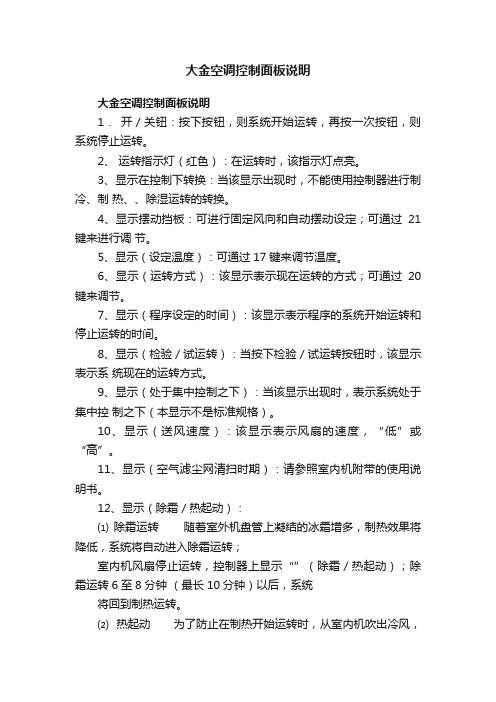
大金空调控制面板说明大金空调控制面板说明1.开/关钮:按下按钮,则系统开始运转,再按一次按钮,则系统停止运转。
2、运转指示灯(红色):在运转时,该指示灯点亮。
3、显示在控制下转换:当该显示出现时,不能使用控制器进行制冷、制热、、除湿运转的转换。
4、显示摆动挡板:可进行固定风向和自动摆动设定;可通过21键来进行调节。
5、显示(设定温度):可通过17键来调节温度。
6、显示(运转方式):该显示表示现在运转的方式;可通过20键来调节。
7、显示(程序设定的时间):该显示表示程序的系统开始运转和停止运转的时间。
8、显示(检验/试运转):当按下检验/试运转按钮时,该显示表示系统现在的运转方式。
9、显示(处于集中控制之下):当该显示出现时,表示系统处于集中控制之下(本显示不是标准规格)。
10、显示(送风速度):该显示表示风扇的速度,“低”或“高”。
11、显示(空气滤尘网清扫时期):请参照室内机附带的使用说明书。
12、显示(除霜/热起动):⑴ 除霜运转随着室外机盘管上凝结的冰霜增多,制热效果将降低,系统将自动进入除霜运转;室内机风扇停止运转,控制器上显示“”(除霜/热起动);除霜运转6至8分钟(最长10分钟)以后,系统将回到制热运转。
⑵ 热起动为了防止在制热开始运转时,从室内机吹出冷风,室内机的风扇自动停止运转。
控制器上显示“ ”(除霜/热起动)。
13、定时器方式启动/停止钮:由专业人员操作。
14、定时器开/关钮:由专业人员操作。
15、检验/运转钮:本按钮仅可由专业的维修人员进行维修时使用!正常运转时请勿使用!16、程序设定时间钮:使用该钮,可设定程序“启动或停止”系统运转的时间。
17、温度设定钮:使用该钮,可设定温度调节器的设定温度。
18、空气滤尘网清扫指示复位钮:请参照室内机附带的使用说明书。
19、风扇速度控制钮:按该钮,可根据您的要求选择风扇的速度,“低”或“高”。
20、运转方式选择钮:按该钮,可选择系统的运转方式。
控制面板使用方法
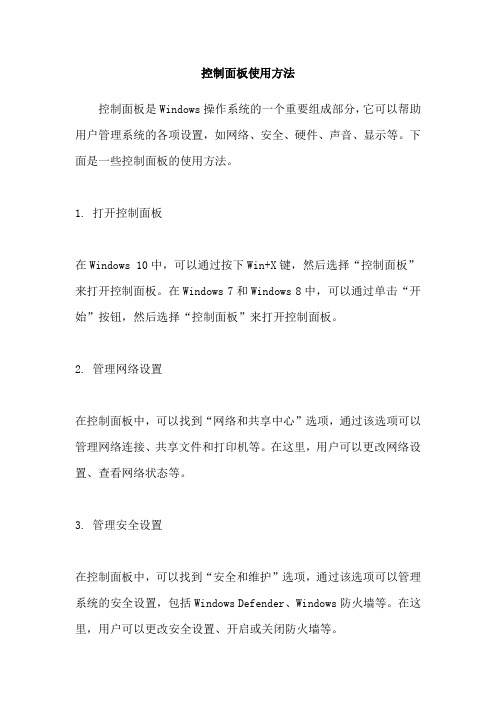
控制面板使用方法控制面板是Windows操作系统的一个重要组成部分,它可以帮助用户管理系统的各项设置,如网络、安全、硬件、声音、显示等。
下面是一些控制面板的使用方法。
1. 打开控制面板在Windows 10中,可以通过按下Win+X键,然后选择“控制面板”来打开控制面板。
在Windows 7和Windows 8中,可以通过单击“开始”按钮,然后选择“控制面板”来打开控制面板。
2. 管理网络设置在控制面板中,可以找到“网络和共享中心”选项,通过该选项可以管理网络连接、共享文件和打印机等。
在这里,用户可以更改网络设置、查看网络状态等。
3. 管理安全设置在控制面板中,可以找到“安全和维护”选项,通过该选项可以管理系统的安全设置,包括Windows Defender、Windows防火墙等。
在这里,用户可以更改安全设置、开启或关闭防火墙等。
4. 管理硬件设置在控制面板中,可以找到“设备和打印机”选项,通过该选项可以管理系统的硬件设置,包括打印机、扫描仪等。
在这里,用户可以更改硬件设置、安装或移除设备等。
5. 管理声音设置在控制面板中,可以找到“声音”选项,通过该选项可以管理系统的声音设置,包括音频输入、输出设备、音量等。
在这里,用户可以更改声音设置、测试音频设备等。
6. 管理显示设置在控制面板中,可以找到“显示”选项,通过该选项可以管理系统的显示设置,包括屏幕分辨率、屏幕亮度等。
在这里,用户可以更改显示设置、调整色彩等。
总之,控制面板是Windows操作系统的一个重要组成部分,它可以帮助用户管理系统的各项设置,使得用户可以更加方便地控制和调整系统的各项功能。
伊莱克斯 ENN2859AOW 进口嵌入式两门冰箱 使用说明书
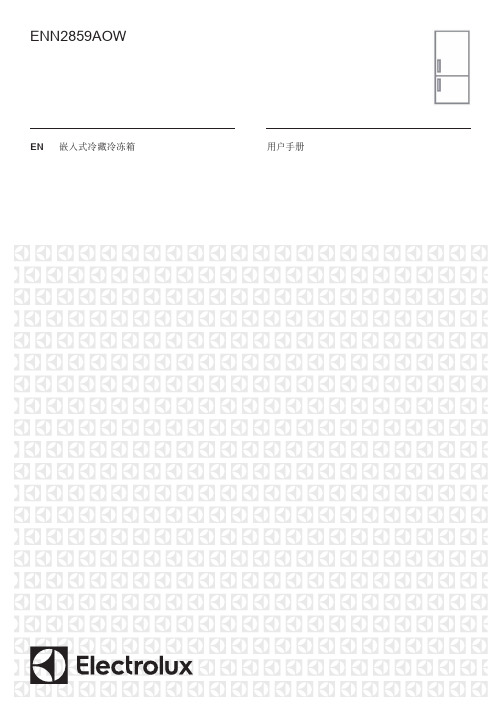
嵌入式冷藏冷冻箱 EN用户手册ENN2859AOW2 目录1. 安全信息 (2)2. 安全说明 (4)3. 操作 (5)4. 日常使用 (8)5. 建议和提示 (10)6. 养护和清洁 (11)7. 故障排除 (12)8. 安装 (14)9. 噪音 (15)10. 技术数据 (16)11. 环保信息 (17)想您所想感谢您选购伊莱克斯电器。
您选择的产品蕴含着我们数十年的专业经验和创新。
该产品集独创性和时尚性于一身,在设计过程中想您所想,是您的不二之选。
每次使用时,都可安心畅享其超凡效果。
欢迎来到伊莱克斯的世界。
获取使用建议、手册、故障排除和维修服务信息,请访问我们的官方网站 或者拨打全国统一客服热线 9510 5801如需获得更好的服务,请在我们的官方网站注册您的产品。
客户关怀与服务请始终使用原厂备件。
在联系我们的授权服务中心时,请确保提供下列信息:型号、PNC 和序列号。
您可在铭牌上找到这些信息。
警告/安全警示信息一般信息和温馨提示环保信息1. 安全信息请在安装和使用本机之前,仔细阅读随附的说明。
对于不当安装或使用本机而造成的任何伤害或损害,制造商不承担任何责任。
请妥善保管操作说明,并置于易于取用的地方,供将来参考之用。
中文3 1.1 儿童和弱势群体安全注意事项• 8岁以下的未成年人不可使用本电器。
对于8 岁及以上的未成年人和存在身体缺陷、感官或精神障碍或缺乏相关经验及知识的人员仅可在具备相应经验与知识的监护人监督下并了解所涉及危害的情况下进行使用。
• 请勿让未成年人玩弄本电器。
• 请确保所有包装材料均远离未成年人并对其进行适当处理。
• 在电器运行或冷却过程中,电器表面及腔体内部温度很高。
请确保在电器运行或冷却过程中未成年人和宠物远离本电器。
• 如果本电器具有儿童安全装置,应将其启用。
• 未成年人和存在身体缺陷、感官或精神障碍或缺乏相关经验及知识的人员不建议对本电器进行任何清洁和用户维护操作。
控制面板 CP600 2代 CP6407、CP6410、CP6415 操作指南说明书
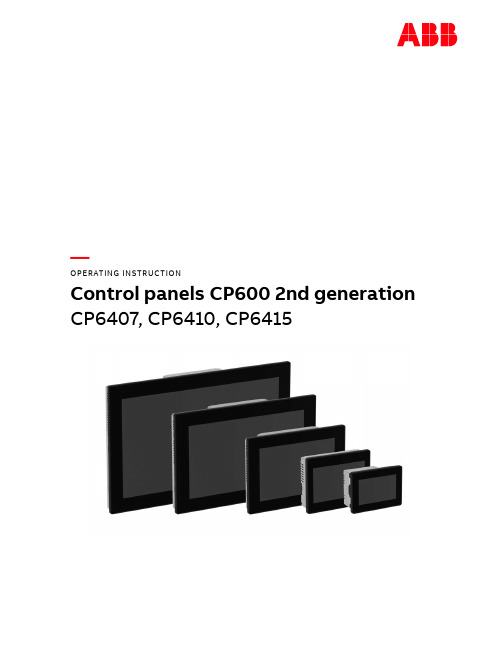
—OPERATING INSTR UCTIONControl panels CP600 2nd generation CP6407, CP6410, CP6415Contents1Introduction (3)2Safety guide (4)2.1Safety guide (4)2.2Safety notices (4)2.3Markups (5)3Product overview (6)4Standards and approvals (7)4.1Product identification (7)5Technical specifications (9)6Technical data (11)6.1Dimensions (12)6.2Installation environment (13)6.3Safety instruction (14)6.4Installation procedure (14)7Connections (15)7.1CP600 2nd generation (15)7.2Serial port (16)7.3Ethernet port (16)8Power supply, grounding and shielding (17)9Battery (19)9.1Dispose of batteries (19)10Special instruction for use (20)11Cleaning faceplates (20)12Getting started (20)13System settings (21)14Unpacking and packing instructions (23)2 3ADR010470, 3, en_USCONTROL PANELS CP600 2ND GENERAT IONCP600 2nd generation, 3, en_US 31 IntroductionThe operational guidelines described below are information on device technical data, installation, transportation, storage, assembly, use and maintenance. The Manual refers to the following models: PictureType DescriptionCP6407Operator interface with 7” color widescreen display and resistive touchscreenCP6410Operator interface with 10”4 color display and resistive touchscreeCP6415Operator interface with 15” color display and resistive touchscreen2Safety guide2.1Safety guideThe manual contains safety standards that must be respected for the personal safetyand to avoid damage.Indications of attention are divided into three levels of severity.2.2Safety notices4 3ADR010470, 3, en_USCONTROL PANELS CP600 2ND GENERAT ION2.3MarkupsEnumeration.Precondition for an operation instruction or a description.Operation instruction with one step.1. Operation instruction with several steps.Result of an operation.CP600 2nd generation, 3, en_US 53Product overviewCP600 2nd generation HMI products combine state-of-the-art features and great perfor-mance in a compact and robust design.They have been designed to offer competitive price/performance ratio for challenging indus-trial applications where robust devices are a requirement.These products feature a full die-cast aluminum housing. Compatibility with CP600 seriescut-out offers an easy upgrade path for the old series.CP600 2nd generation products have been designed to run PB610 software with outstandingcommunication and graphical options.•Efficient and secure Linux operating system•Gateway function with Server and Client OPC UA•aFull PB610 vector graphic support•Efficient unified programming strategy for web HMI applications6 3ADR010470, 3, en_USCONTROL PANELS CP600 2ND GENERAT ION4Standards and approvalsThe products have been designed for use in an industrial environment in compliance with the2014/30/EU EMC Directive.The products have been designed in compliance with:EN 61000-6-4EN 61000-6-2 EN 61000-4-2EN 61000-4-3EN 61000-4-4EN 61000-4-5EN 61000-4-6EN 61000-4-8EN 61000-4-29EN60945The installation of these devices into the residential, commercial and light-industrial environ-ments is allowed only in the case that special in measures are taken in order to ensure con-formity to EN 61000-6-3.The products are in compliance with the Restrictions on Certain Hazardous Substances(RoHS) Directive 2011/65/EUIn compliance with the above regulations the products are CE marked.4.1Product identificationThe product may be identified through a plate attached to the rear cover. You will have toknow the type of unit you are using for correct usage of the information contained in theguide.An example of this plate is shown in the figure below:Note: the CP6407 label is used as an example for CP600 2nd generation Series.CP600 2nd generation, 3, en_US 783ADR010470, 3, en_USInformation on type plate (example) Description Product model name CP6407Product part number 1SAP540710R0001Serial number S.N.: AAxxxxxxxxxxxxxxxxAA Product version ID V.: xxxxxxxxxxxxxxx Manufacturer addressABB AGEppelheimer Straße 82, 69123 HeidelbergGermanyCONTROL PANELS CP600 2ND GENERAT IONCP600 2nd generation, 3, en_US 95 Technical specificationsTouchscreen technology ResistiveBack-up battery3 V 50 mAh Lithium, rechargeable, not user-replaceable, model VL2330.Fuse AutomaticSerial port RS-232, RS-485, RS-422 software configurable Flash 4 GB RAM512 MBHardware clock Clock/Calendar with back-up battery Accuracy RTC (at 25°C) < 100 ppmEnvironmental conditions Operating temperature -20 … +60 °C (vertical installation) EN 60068-2-14 Storage temperature-20 … +70 °CEN 60068-2-1 EN 60068-2-2 EN 60068-2-14 Operating and storage humidity 5 … 85 % RH not-condensing EN 60068-2-30Vibrations 5 … 9 Hz, 7 mm; 9 … 150 Hz, 1 g p-p EN 60068-2-6 Shock± 50 g, 11 ms, 3 pulses per axis EN 60068-2-27 Protection classFront panel IP66, Rear IP20EN 60529Electromagnetic Compatibility (EMC) Electrostatic discharge immunity test8 kV (air electrostatic discharge)4 kV (contact electrostatic discharge)EN 61000-4-2Radiated, radio-frequency, electromagnetic field immunity test 80 MHz … 1 GHz, 10 V/m 1.4 GHz … 2 GHz, 3 V/m 2 GHz … 2.7 GHz, 1 V/m EN 61000-4-3Burst immunity test±2 kV DC power port±1 kV signal lineEN 61000-4-4Surge immunity test ±0,5 kV DC power port (line to earth) ± 1 KV dc power port (line to line) ±1 kV signal line (line to earth) EN 61000-4-5Immunity to conducted disturbances inducted by radiofrequency field0.15…80 MHz, 10 VEN 61000-4-6Power frequency magnetic field immunity testEnclosure, 50 Hz, 30 A/m EN 61000-4-8Voltage dips, short interruptions and voltage variations immunity test Port: DC mains; Level:0% duration: 10 ms 20 spaces by 1 sTest executed on the 24 VDC of the EUTEN 61000-4-29Durability informationBacklight service life (LED type) 40000 hr. or more(Time of continues operation until the brightness of the backlight reaches 50 % of the rated value when the ambient temperature is 25 °C) - see Note 1Note 1: Extended use in environments where the ambient temperature is 40 °C or higher may degrade backlight quality/reliability/durability.10 3ADR010470, 3, en_US6Technical dataModel CP6407 CP6410 CP6415Display TFT Color / LED TFT Color / LED TFT Color / LEDColors 64K 64K 64KResolution 800X480 800X600 1024X768Diagonal 7” widescreen 10.4” 15”Dimming yes yes yesFlash 4GB 4GB 4GBSD card slot yes yes yesRAM 512MB 512MB 512MBSerial port RS-232,RS-485, RS-422software configurable RS-232,RS-485, RS-422software configurableRS-232,RS-485, RS-422software configurableEthernet port 2 10/100Mb 2 10/100Mb 2 10/100MbUSB port 2 Host interface ver-sion 2.01 max. 100mA, 1 max.500mA 2 Host interface ver-sion 2.01 max. 100mA, 1 max.500mA2 Host interface ver-sion 2.01 max. 100mA, 1 max.500mABattery rechargeable rechargeable rechargeableRTC yes yes yesVoltage 24Vdc (*) 24Vdc (*) 24Vdc (*)Current ratingat 24Vdc0.35A 0.40A0.70AWeight 1.0 Kg 2.0 Kg 3.5 Kg* 10-32VdcFor applications requiring compliance with EN 61131-2 and specifically in reference to 10 ms voltage dips, the power supply range voltage is 18-32Vdc.6.1DimensionsA B C H LCP6407 176 mm6.92”136 mm5.35”40 mm1.57”147,5 mm5.80”187,5 mm7.38”CP6410 276 mm10.86” 221 mm8.70”40 mm1.57”232,5 mm9.15”287,5 mm11.31”CP6415 381 mm15” 296 mm11.65”45 mm1.77”307,5 mm12.10”392,5 mm15.45”6.2Installation environmentAvoid prolonged exposition to direct sunlight to avoid the risk of overheating the device.The equipment is not intended for installation in contact with corrosive chemical compounds. Check the resistance of the front panel to a specific compound before installation.Do not use tools of any kind (screwdrivers, etc.) to operate the touch screen of the panel.In order to meet the front panel protection classifications, proper installation procedure must be followed:•The borders of the cutout must be flat•Screw up each fixing screw until the bezel corner get in contact with the panel.•The cutout for the panel must be of the dimensions indicated in this manual.The IP66 is guaranteed only if:•Max deviation from the plane surface to the cut-out: ≤ 0.5 mm•Thickness of the case where is mounted the equipment: from 1.5 mm to 6 mm•Max surface roughness where the gasket is applied: ≤ 120 μmA.CP64xxB.Installation cut-out6.3 Safety instruction6.4 Installation procedurePlace the fixing brackets contained in the fixing kit as shown in figure.7Connections7.1CP600 2nd generation1.Serial port2.Ethernet Port 03.Ethernet Port 1B Port V2.0, max. 500 mAB Port V2.0, max. 100 mA6.Power Supply7.SD Card Slot7.2 Serial portThe serial port is used to communicate with the PLC or with another type of controller. Different electrical standards are available for the signals in the PLC port connector: RS-232, RS-422, and RS-485.The serial port is software programmable. Make sure you select the appropriate interface in the programming software.Pin RS-232RS-422, RS-4851 GNDGND23 TX CHA-4 RXCHB-56 +5V output +5V output7 CTS CHB+8 RTS CHA+ 9To operate in RS-485 pins 7-8 and 3-4 must be connected externally.The communication cable must be chosen for the type of device being connected.7.3 Ethernet portThe Ethernet port has two status indicators. Please see description in figure.YellowOFF: Valid link has NOT been detected ON: Valid link has been detectedGreenON: No activity BLINKING: Activity8Power supply, grounding and shielding The power supply terminal block is shown in the figure below.Pin Description1 +24 V DC (L+)2 Common (M)3 Ground3 conductors 1,5 mm2 wire size minimum, minimum temperature conductor rating 105 °C.The unit must always be grounded to earth with 1,5 mm2 wire size minimum. Grounding helpslimit the effects of noise due to electromagnetic interference on the control system.Earth connection will have to be done using either the screw or the faston terminal locatednear the power supply terminal block. A label helps identify the ground connection. Also con-nect to ground the terminal 3 on the power supply terminal block.The power supply circuit may be floating or grounded. In the latter case, connect to groundthe power source common as shown in figure (see below) with a dashed line. When using thefloating power scheme, note that the panes internally connects the power common toground with a 1 MΩ resistor in parallel with a 4,7 nF capacitor. The power supply must havedouble or reinforced insulation. The suggested wiring for the power supply is shown below.All the electronic devices in the control system must be properly grounded. Grounding must be performed according to applicable regulations.9 BatteryCP600 2nd generation panels are equipped with rechargeable Lithium battery, not user-re-placeable.The hardware real-time clock (date and time) is maintained by the battery.When the battery is fully charged, it ensures a period of 3 months of data backup at 25 °C.Location of the battery: See “broken circle” in the picture below.9.1Dispose of batteries10Special instruction for use•Install the HMI device according to the accompanying installation instructions.•Ground the HMI device according to the accompanying installation instructions.•Only qualified personnel may install the HMI device or repair it.•Ensure that the aeration holes are not covered.•Care shall be taken not to allow layers of dust to form on the faceplate of the HMI device in a way that might cause the accumulation of static charges.Keep the faceplate of the HMI device clean: the equipment must be cleaned only with asoft cloth and neutral soap product. Do not use solvents.•This device should not be used for purposes and methods other than indicated in this document and in the documentation accompanying the product.11Cleaning faceplates12Getting startedCP600 2nd generation control panels must be programmed with the software PB610.PB610 Panel Builder is a software tool that must be properly installed on a computerrunning Microsoft Windows.There are two options to transfer a PB610 application project to a CP600 2nd generation de-vice:Ethernet Connect the CP600 2nd generation device to the computer with an Ethernetnetwork connection. From PB610 choose the command Run/Download to tar-get. You may have to ensure that the proper firewall policy has been config-ured in the computer to allow PB610 Panel Builder to access the network.USB Create an Update Package using PB610 Panel Builder and copy it to a USBFlash drive.CONTROL PANELS CP600 2ND GENERAT ION CP600 2nd generation, 3, en_US 2113 System settingsCP600 2nd generation control panels have a system settings interface to allow configurationof system options.The user interface of System Settings is based on HTML pages accessible locally on CP600or in remote using a Web browser Chrome v44 or higher on port 443(https://IP /machine_config). Default username is “admin”, default password is “admin”.Use navigation menu on the left side of the screen to browse through the available options.The active item of menu is highlighted on the left side. The right side shows relatedinformation and settings. Based on the size of the CP600 2nd generation screen, both menuand content of selected item may be shown on screen or not.Two modes of operation can be selected in the System Settings:User ModePB610 runtime is running or the CP600 2nd generation device is in “factory default” status. System Mode PB610 runtime is not running or the CP600 2nd generation devicehas a software failure. System Mode includes all options available inUser Mode and offers in additions commands dedicated to systemupgrade and recovery not available when running in User Mode.Activation of System Settings in User Mode:PB610 runtime not runningPress “System Setting” button on the CP600 2nd generation screen. PB610 runtime running Recall context menu and select “System Settings”. To recallthe context menu click and hold any unused area of thetouchscreen for a few seconds.Default hold time is 2 seconds.Activation of System Settings in System Mode:Normal operation If PB610 runtime is not running: Press “System Setting” button onthe CP600 2nd generation screen to enter in System Settings inUser Mode.Select “Restart” → “Config OS” to reboot in System Mode.If PB610 runtime is running: recall context menu and select “SystemSettings”. To recall the context menu click and hold any unused areaof the touchscreen for a few seconds.Default hold time is 2 seconds to enter in System Settings in UserMode.Select “Restart” → “Config OS” to reboot in System Mode. Recovery operation If panel is not responsive, use the so-called “tap-tap” procedure.This procedure consists in tapping the surface of the touchscreenduring the device power-up phase. Tapping frequency must be high.You have to start tapping the touchscreen as soon as power hasbeen applied to the device. When the sequence has beenrecognized, the system shows the message: “TAP-TAP DETECTED”.At this point release touch to boot in User Mode without runningPB610 runtime or press and hold few seconds (selecting so“RESTART: CONFIG OS”) to boot in System Mode.System Settings includes options for basic settings of the device.Language Configure language used for System Settings menu only.System Show information about platform, status and timers (e.g. Systemon time, backlight on time).Logs Enable persistent log for BSP and allows to export it.Date & Time Change the device date and time, including time zone andNTP ServerNetwork Configure IP Address of Ethernet interface and the other networksettings like DNS, Gateway, DHCP, Hostname, routing and bridging. Services Enable/disable services. Example of services are: Open SSH server,Cloud services, SNMP and logging.Management Update of BSP components (Main OS, Config OS, Boot loader,XLoader), check for partitions consistence, update of splash screen,information about usage and size of partitions. The update of MainOS is available only in System Mode, the update of Config OS is onlyin User Mode.Display Adjust brightness, configure automatic backlight turnoff and selectCP600 2nd generation orientation (90°, 180°, 270° and 360°). Restart Restart the device. “Main OS” option restarts as per default in UserMode, “Config OS” option restart panel directly into System Set-tings in System Mode.Authentication Configure password for administrator (“admin”) and for the stand-ard user (“user”). Administrator has full access to System Settings(updates of BSP and other system components).Standard user has some limitations.22 3ADR010470, 3, en_USCONTROL PANELS CP600 2ND GENERAT ION CP600 2nd generation, 3, en_US 2314 Unpacking and packing instructions3A D R 010470, 3, e n _U S © Copyright 2020 - 2021 ABB.All rights reserved.—ABB AGEppelheimer Straße 8269123 HeidelbergGermanyPhone: +49 6221 701 1444Fax: +49 6221 701 1382E-Mail:****************.com /plc/automationbuilder Note:We reserve the right to make technical changes or modify the contents of this document without prior notice. With regard to purchase orders, the agreed particulars shall prevail.ABB AG does not accept any responsibility whatsoever for potential errors or possible lack of information in this document.We reserve all rights in this document and in the subject matter and illustrations contained therein.Any reproduction, disclosure to third parties or utilization of its contents – in whole or in parts – is forbidden without prior written consent of ABB AG.。
血细胞比容离心机
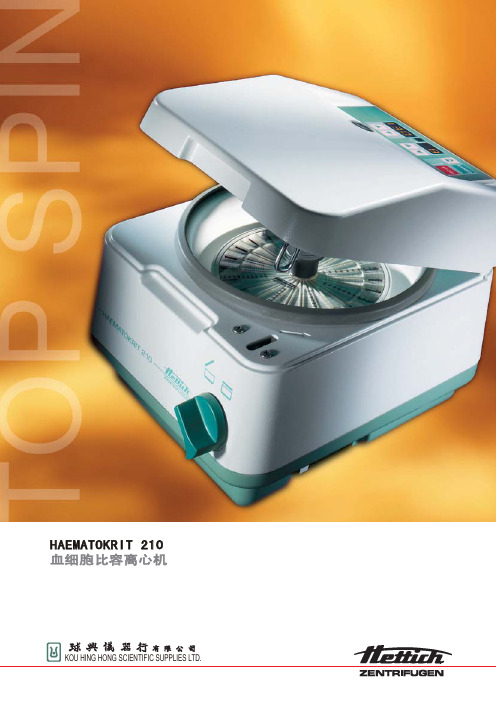
KOU HING HONG SCIENTIFIC SUPPLIES LTD.
香 港 (852) 2391 7783 广 州 (020) 3766 3378 上 海 (021) 5854 0660 厦 门 (0592) 2187 237 北 京 (010) 8262 5269 网 址
2076转子的支撑盘,当玻璃破损 时容易清理和弃置.
毛细管目录号
密封油灰
2074
1072
1071
目录号
HAEMATOKRIT 210 控制面板 (E型控制面板)
2077
转子, 20位 转子 20
用于血沉棕黄层定量分析法的毛细管,带盖 (不适合标准毛细管)
用户便利性
快速输入轻触式键盘 · 容易阅读数字显示 · 显示正在使用参数数值 ● 参数输入容易 · RPM输入单位:100 · 时间输入单位:分钟,最大99分钟
血细胞比容转子, 血细胞比容转子, 24位
用于标准毛细管,包括盖(可作为评估盘)
目录号 2076
用于血沉棕黄层定量分析法的毛细管,在20 位的转子先经过离心,之后再做进一步分析.
毛细管数量/转子 毛细管,肝素涂层 basic
24支标准毛细管 mylarcoated
self-sealing 和 mylar-coated
HAEMATOKRIT 210 血细胞比容离心机
KOU HING HONG SCIENTIFIC SUPPLIES LTD.
HAEMቤተ መጻሕፍቲ ባይዱTOKRIT 210
强大的离心能力(RCF值:16060)可在6分钟多 左右完成沉淀.即使在不同的转速,10分钟的 运行时间一定足够,之后转子会通过刹车停 止转动. 在2076转子,每支毛细管固定在单独的腔体 和有支撑盘支持.当发生毛细管破裂时,支撑 盘可以容纳玻璃碎片和漏液.也容易清洁和 丢弃破损的玻璃.
- 1、下载文档前请自行甄别文档内容的完整性,平台不提供额外的编辑、内容补充、找答案等附加服务。
- 2、"仅部分预览"的文档,不可在线预览部分如存在完整性等问题,可反馈申请退款(可完整预览的文档不适用该条件!)。
- 3、如文档侵犯您的权益,请联系客服反馈,我们会尽快为您处理(人工客服工作时间:9:00-18:30)。
User guide for EZ-USB Control PanelUser guide for EZ-USB Control Panel.An Overview of the EZ-Usb Control Panel.The EZ_USB Control Panel allows the user to generate USB requests to the Anchor Chips supplied USB driver. Standard USB requests are supported as well as EZ-USB specific requests. The standard USB device requests are documented in Chapter 9 of the USB spec.The control panel supports the following operations:• Get descriptors• Download software• Send/receive bulk data from the screen or a file• Send/receive isochronous data• Loop back testsThe USB devices which are found to be available by the Operating System are identified and presented to the user. Those devices may be selected to operate as the target of some USB operation. A given USB device may have several USB Pipes and Endpoints available to it. The Anchor Chips EZ-USB device, for instance loads a default setting with 12 pipes and endpoints associated with it.When the application is initially started, it checks for available EZ-USB devices on the USB bus. Devices which are found are each given their own window in the main application into which the users may enter commands and view output from the device. Available devices may also be identified by selecting the pulldown menu to the left of the "Clear" button.To start an operation, select the operation from the box next to the "send" button. This will change the toolbar so that it can accept information for that command. Fill in the information and press the "send" button to send the command over the USB bus.{overview.gif}The Application Toolbar.The Application Toolbar has standard buttons such as Cut, Copy, Paste, Save, and Print, as well as an “About” button to get Version information.It contains a “Select Target” button to allow the user to specify that an EZ-USB target is being used, or that an FX2 target is being used. These two targets differ in that Hold/Release is performed differently for each. In addition, a different default monitor file is used for the two targets.It contains a “GPIF Tool” button to launch the GPIF Tool application.{17_tpapp.gif}The Main Screen.The Main screen shows a toolbar containing a dropdown menu of standard USB requests and a "Send" button to initiate transfer of the commands. This "operations" toolbar also contains the Device and Interface identification strings associated with the USB device. It contains a "Clear" button to clear the contents of the output buffer, and a "Load Monitor" button to download the monitor code to the USB Device. The monitor code allows the use of a serial debug monitor while developing target 8051 code.Note: If your screen doesn't contain a "EZusb-0" window, see the troubleshooting chapter below. Below the operations toolbar is a text window which contains the output generated to debug USB transfers. As commands are sent and received, diagnostic text is added to this window. It is a generic text window with the normal operations such as search, save, and print. The USB commands and their parameters are printed out as they are sent or received. When the user selects a USB command from the pull down menu, another ToolBar may be displayed to allow the user to enter parameters for a USB command.{mainscrn.gif}Hot Plugging New DevicesWhen the Control Panel application is started, it checks for USB devices on the bus. If an EZ-USB device is plugged in after having started the application, it will not be recognized immediately. For the new device to be recognized by the application, select "File\Open All Devices" to open a new window with the new device selected and ready to receive commands.The Properties Dialog.The General Page.The Verbose Mode option allows the user to select a more verbose output from the content of transferred messages.The Pop Up Command ToolBars option allows the user to select how they want to view the operation ToolBars. They may view the ToolBars one at a time so the appropriate ToolBar pops up when the operation is selected. Alternatively, they may clear the selection box so that the operation toolbars are all displayed at once. This creates a busier display, but may be desirable when the user has a large screen area or is familiar with the available operations and wants to select them more quickly.Automatically Hold during download, then Run: automates this chore instead of using the HOLD/RUN buttons.Use separate thread for each USB operation: Prevents USB operations from hanging the Control Panel. Max Operations Pending limit: Specifies the maximum number of operations pending. If the user runs up against this limit (for instance by repeatedly trying to read from an empty pipe) then further operations will not be started. The user may increase this limit at any time, thereby allowing them to send an operation which should clear the pending operations (such as writing to an output pipe).{general.gif}The Paths Page.The Monitor File Location.This allows the user to select the default location of the monitor code. See Cypress\USB\Target\Monitor for alternative monitor files. The user can select the default monitor using the browse button, and the selected monitor will be downloaded when the user presses the "Load Monitor" button on the main operations ToolBar.{paths.gif}Exiting the Program.When the User exits by selecting "File/Exit" or by pressing the "x" in the upper right corner, the user may be asked if they wish to save the contents of the output buffer. A dialog box is displayed which allows the user to save the contents of a modified output buffer.File Menu Commands.{menufile.gif}Open All Devices: Poll for available USB devices and enter all available devices into pull-down lists. Then open a view for all devices that were found.Edit Menu Commands.{menuedit.gif}View Menu Commands.{menuview.gif}Window Menu Commands.{menuwind.gif}Options Menu Commands.{menuopt.gif}Tools Menu Commands.{tools.gif}The tools menu will display whatever Cypress tools are installed on your PC. The menu content is variable. Help Menu Commands.{menuhelp.gif}Unary Operations ToolBar.{tbuna.gif}The Unary Operations need no parameters (except the possible selection of a target file).There are several such operations collected on the Unary Operations toolbar as follows:Get Device Descriptor: Get Device Descriptor standard call.Get Configuration Descriptor: Get Configuration Descriptor standard call.Get Pipes: Uses "Get Pipe Info" IOCTL to get the pipe/endpoint configuration information from the driver. The driver maintains this information in memory, so no USB traffic is actually generated from this command.Get String: gets string descriptors (it is hard coded to get the strings with index 1 and 2). This is normally the Manufacturer string index and Product string index (which is seen when you plug in the device). Download: Download a target (*.hex) file.Re-Load: Re-Load the last target file.EEPROM: Select EEPROM file to download file contents to EEPROM.URB Stat: gets the most recent USB Error status reported.Multiple USB errors (Indicated by the generic “Endpoint Error”) map to a single IOCTLError. The IOCTL errors are normally reported directly by the Control Panel, but such a USB errorwill now indicate “Endpoint Error” instead.Pressing URB stat will manually request the last URB (USB Request Block) error.Please be aware that some types of errors (like a bad parameter in the IOCTL) would fail beforegetting to USB, so the error code would be meaningless.Pressing “URB Stat” (as has been done in the screenshot above) will give you the value of the lastUSB error, and will decode the error If possible.Hold: Put 8051 Reset into Hold state.Run: Put 8051 Reset into Release state.Vendor Request ToolBar.{tbvend.gif}The Vendor Request parameters are entered here.NOTE: Please see the EzUsb General Purpose Driver Spec for more detailed information onVendor Specific Request parameters.The Vendor Specific Request parameters are dependant on the program running on the target.For instance, the C:\Anchor\Examples\Vend_Ax.hex program may be loaded on to the Development Board. This implements several Vendor Specific Requests (see the readme file in that diretory).Once the Vend_Ax.hex program is loaded, you can modify the Req Field to send different requests,such as reading the contents of the EEPROM on the Development Board.Request: ID representing request type.Value: Hex value.Index: Index value.Length: Length field.Direction: 0=Out; 1=In.Hex Bytes: Byte field for data.Isochronous Transfer ToolBar.{tbiso.gif}The Isochronous Transfer parameters are entered here.The overall size of an Iso transfer is limited to 1MB.When the Iso Trans button is used for a transfer out, a buffer is filled with incrementing words of ISO data. If you wish to send a file of specific data for the ISO transfer out, you should use the File Trans buttonOn the pipe operations bar.NOTE: See the "EzUsb General Purpose Driver Spec" for more detailed information on Iso Transfers. Pipe: Select Pipe or Endpoint for operation.PktCount: Number of Packets.This is the number of frames of ISO data to read from the device.ISO transfers occur every USB frame (1ms).For example, a PacketCount of 3000 would indicate 3 seconds of ISO data.This parameter must be evenly divisible by the product of the next two parameters that is: (PacketCount mod (FramesPerBuffer * BufferCount)) must be zero.PktSize: Size of Packets in bytes.This is the amount of ISO data to read during each frame.This value usually corresponds to the max packet size of the ISO endpoint, but can be less.BuffCount: Number of buffers to use.This is the number of transfer URBs to use for thistransfer. 2 is a good default value.FrmPerBuff: Frames per buffer.This is the number of USB frames of data to transfer in a single URB (USB Request Block).10 is a good default value.Bulk Transfer ToolBar.{tbblk.gif}The Bulk Transfer (byte mode) parameters are entered here.Pipe/End: Select Pipe or Endpoint for operation.Length: Size of transfer.Blk Loop: Run a loop test by sending data out an OUT endpoint and reading it into an IN endpoint. This requires the presence of a special program running on the EZ-USB device which ties the endpoints together in a loop (currently this will work with C:\Anchor\USB_Ctrl\Examples\ep_pair.hex which ties pipes-endpoints together). Note that this file must be loaded first.Hex Bytes: Hex Data Bytes.Pipe Operations ToolBar.{tbreset.gif}The Pipe Operations parameters are entered here.Pipe/End: Select Pipe or Endpoint for operation.Op: Allows user to specify Pipe Operation.File Trans..: The File Transfer button allows you to select ISO or BULK endpoints as targets of a file based operation. When this button is pressed, You will be prompted for a file name. If you have an OUT pipe selected, the file will be opened and transferred through the OUT pipe. If an IN pipe is selected, the file will be created and filled with the data that comes in the pipe (which will have to be generated by the 8051 somehow). There is a sample file: C:\Anchor\EZUSB\TARGET\Test\64_Count.hex that is a typical hex file, which can be selected to send out an OUT port. It is simple to load the ep_pair, example for instance, and send the 64_count.hex file out over the USB bus. The hex files used are raw hex values which can be generated and viewed with any standard hex editor.Set Interface ToolBar.{tbint.gif}The Set Interface parameters are entered here.Interface: Select Interface Index.Alternate Setting: Select Alternate Setting index.TroubleshootingWhy don't I see an EZ-USB0 window??If the program starts up with a shortened menu and no toolbar, it means thatyou don't have a USB device installed.Since USB is real plug and play, you just have to plug in the device and select"file/update_all_devices" , then "file/open_all_devices" to see it.I tried plugging the device in and selecting open All Devices, but I still don't see it.This indicates that your device isn't loading the driver. Several possible problems are:Device isn't powered. Make sure the jumper near the USB connector is in the "BUS" position.Driver wasn't loaded. Go to the Windows Control Panel, select System/usb devices/anchor dev board. Select "update driver" to re-configure the driver in the registry.USB connector isn't properly connected to your motherboard.Device type programmed in the EEPROM (U9) that doesn't match the ezusb.inf file. If you reprogrammed the EEPROM and can't recover, you can pull the EEPROM off of the board to revert to the VID/PID of 547/2131.My software says that it loads, but it doesn't run.Make sure that your file is in hex format. This is always the preferred format.If you are using a bix file, you can only download to the lower 8K of memory (0-1fff).For larger images, always use the hex file format.The memory map switches are not in the proper position.Switch 3 should be ON and switch 4 should be OFF to use all of the external RAM (for Series 2100).You plug in the EZ-USB Development Board and the system respondswith a message saying "unknown device".Please perform the following procedure (for Win9x only):1.) Unplug the development board.2.) Remove (or rename) file"C:\Windows\System\Inf\Drvidx.bin"3.) Remove (or rename) file"C:\Windows\System\Inf\Drvdata.bin"(These are the 2 largest files in the INF directory).4.) When you plug the EZ-USB Development Board backinto the PC, it should be recognized and loaded automatically.。
